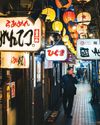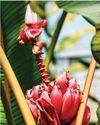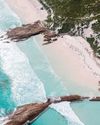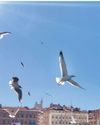
I SAW THE MOAI for the first time at sunset, lording over the coast of Easter Island, or Rapa Nui, like giant warriors armored in gold.
At an average 13 feet tall and weighing as much as 14 tons, these remarkable figures, set against the backdrop of the Pacific Ocean, looked more human-like as I walked closer. One was wide-eyed; another stern. Their neighbor up the hill appeared winsome.
There are nearly 1,000 moai (which means "statues" in the Rapanui language) on this Chilean territory. They are thought to have been hewn between the 12th and 17th centuries, after Polynesians voyaged to the middle of the earth's largest ocean in search of new lands, came upon a fertile, unpopulated island, and settled there.
During the 18th and 19th centuries, production of the moai stopped as the islanders faced enslavement by Peruvian raiders, escalating civil unrest, and disease.
By the early 2000s, the moai had created a $120 million travel industry-more than 150,000 visitors from around the world were going to see them each year.
And then, in March 2020, everything stopped. Fearing the island's only hospital (with just three ventilators) was ill-equipped for the pandemic, the island's mayor, Pedro Edmunds Paoa, asked LATAM Airlines to cancel all flights into Mataveri International Airport, the world's most remote commercial airfield. This effectively cut the island off from the rest of the world in a way it hadn't been since the late 1960s, when the first propeller planes crossed the South Pacific from Santiago. At the time, 72 percent of the island's 7,750 residents worked directly in tourism. In an instant, not only were there no visitors but there was little in the way of supplies.
Diese Geschichte stammt aus der February 2024-Ausgabe von Travel+Leisure US.
Starten Sie Ihre 7-tägige kostenlose Testversion von Magzter GOLD, um auf Tausende kuratierte Premium-Storys sowie über 8.000 Zeitschriften und Zeitungen zuzugreifen.
Bereits Abonnent ? Anmelden
Diese Geschichte stammt aus der February 2024-Ausgabe von Travel+Leisure US.
Starten Sie Ihre 7-tägige kostenlose Testversion von Magzter GOLD, um auf Tausende kuratierte Premium-Storys sowie über 8.000 Zeitschriften und Zeitungen zuzugreifen.
Bereits Abonnent? Anmelden

Oodles of Noodles
Slurping through a lantern-lit alley in Sapporo, Japan, where miso ramen was born

The Sweet Spot
Just an hour south of Miami, Nora Walsh finds a candyland of tropical fruits ripe for picking.

Freshly Brewed
In the Cederberg Mountains of South Africa, Kendall Hunter discovers the powerful effects of the humble rooibos plant.

SHORE LEAVE
Raw, wild, and mind-bendingly remote, yet peppered with world-class wineries and restaurants-Australia's South West Edge is a study in contrasts.

Of Land and Sea
Savoring French flavors on a gastronomic trail between Marseille and Dijon.

FAMILY-STYLE
Food writer MATT GOULDING couldn't wait to get back to the hushed omakase restaurants of Tokyo, Kyoto, and Osaka. But would his young kids love the country-and its cuisine as much as he does?

HAPPY MEAL
Many tascas, the no-frills dining spots in Lisbon, have vanished. But others, Austin Bush discovers, are being lovingly reinvented.

A City Abuzz
In underappreciated Trieste, Taras Grescoe finds some of Italy's most storied-and spectacular-coffee shops.

FJORD FOCUS
Norway in December? Crazy-and crazy beautiful. Indulging a family wish, Akash Kapur discovers a world of icy enchantment.

DESTINATION OF THE YEAR Thailand
Full disclosure: I didn't like Bangkok at first. I didn't get it—the chaos, the traffic, the fact that everything was hard to find. But like all good love affairs, my relationship with Thailand—which deepened when I moved from Vietnam 12 years ago to work at Travel + Leisure Southeast Asia, where I'm now editor in chief—took time to blossom.